Top Wildlife Safari Experiences in Sri Lanka
Sri Lanka may be small in size, but this teardrop-shaped island nation packs an extraordinary punch when it comes to wildlife experiences. Blessed with 26 national parks covering nearly 10% of the country’s landmass, Sri Lanka offers some of Asia’s most spectacular safari opportunities. From tracking elusive leopards to witnessing the world’s largest gathering of elephants, here’s a comprehensive guide to the top wildlife safari experiences this island paradise has to offer.
Yala National Park: Land of Leopards
Situated in the southeastern corner of Sri Lanka, Yala National Park stands as the crown jewel of the country’s wildlife sanctuaries. Spanning over 979 square kilometers, it boasts the world’s highest density of leopards, making it a premier destination for big cat enthusiasts.
The park’s diverse landscape encompasses monsoon forests, grasslands, marine wetlands, and sandy beaches, creating varied habitats for an impressive array of wildlife. While the Sri Lankan leopard takes center stage, Yala is also home to elephants, sloth bears, sambars, spotted deer, wild boars, and countless bird species.
The best time to spot leopards is during the dry season (May to September) when animals gather around water holes. Morning safaris starting at dawn offer optimal wildlife viewing opportunities, as animals are most active during the cooler hours. Expert guides can identify subtle signs—scratch marks on trees, paw prints in the sand, or alarm calls from monkeys—that indicate a leopard’s presence.
For photography enthusiasts, the golden light of early morning or late afternoon creates magical conditions for capturing Yala’s breathtaking scenery and wildlife. Patience is key; sometimes the most remarkable sightings happen after hours of quiet observation.
Beyond leopards, Yala’s Block 1 offers excellent opportunities to observe Asian elephants in their natural habitat. These magnificent creatures can often be seen bathing in waterholes or feeding among the scrubland. The park’s avian diversity is equally impressive, with over 215 bird species, including six endemic to Sri Lanka.
Udawalawe National Park: Elephant Territory
For guaranteed elephant sightings, Udawalawe National Park is unrivaled. Created in 1972 as a sanctuary for elephants displaced by the construction of the Udawalawe Reservoir, this park now protects around 500 pachyderms within its 30,821-hectare expanse.
The park’s open terrain, characterized by grasslands and bush forest, offers exceptional visibility, making it ideal for observing elephant behavior. Herds can be spotted year-round, often gathering near water sources during the morning and late afternoon.
What makes Udawalawe special is the opportunity to witness elephants engaged in natural behaviors—mothers teaching calves to forage, adolescent males play-fighting, or entire herds cooling off in the reservoir. The intimate moments between elephant family members reveal the complex social structures and intelligence of these remarkable creatures.
Udawalawe is also home to the Elephant Transit Home, a rehabilitation center for orphaned elephant calves. Visitors can observe the feeding sessions held at three-hour intervals throughout the day. The center’s commitment to returning rehabilitated elephants to the wild makes it an ethical wildlife experience worth supporting.
Beyond elephants, the park shelters water buffalo, sambar deer, crocodiles, and monitor lizards. Birdwatchers will delight in spotting endemic species like the Sri Lanka junglefowl, Sri Lanka spurfowl, and red-faced malkoha among the 184 avian species recorded here.
Wilpattu National Park: The Land of Lakes
Wilpattu, Sri Lanka’s largest national park, offers a safari experience distinct from its southern counterparts. The name “Wilpattu” means “land of lakes,” referring to the numerous natural, sand-rimmed water basins or “villus” that dot the landscape. These water sources attract diverse wildlife, especially during the dry season.
Having suffered closure during Sri Lanka’s civil conflict, Wilpattu reopened in 2010 and remains less crowded than Yala, offering a more serene safari experience. The dense jungle vegetation creates an atmosphere of adventure and discovery as you navigate winding tracks in search of wildlife.
Leopards are the star attraction here too, although they can be more elusive than in Yala due to the thicker vegetation. The park’s leopards are known for their size and distinctive dark-gold coloration. Sloth bears, another highlight of Wilpattu, can often be spotted foraging for termites or fruits.
Wilpattu’s varied habitats support an exceptional diversity of wildlife, including elephants, water buffalo, sambars, spotted deer, and mongoose. The park is also home to the endangered barking deer and the elusive pangolin. Over 200 bird species have been recorded, making it a paradise for ornithologists.
The historical significance of Wilpattu adds another dimension to the safari experience. Ancient ruins within the park boundaries indicate human settlements dating back to the 3rd century BCE, creating an intriguing blend of natural and cultural heritage.
Minneriya and Kaudulla National Parks: The Gathering
One of Asia’s most spectacular wildlife events occurs annually at Minneriya National Park during the dry season (July to October). Known as “The Gathering,” this natural phenomenon involves hundreds of elephants migrating to the shores of Minneriya Tank (reservoir) as water sources elsewhere dry up.
Up to 300 elephants can be seen gathered around the receding reservoir, creating the largest concentration of Asian elephants in the world. The ancient reservoir, built by King Mahasena in the 3rd century CE, becomes a lifeline for wildlife during the dry months.
The adjacent Kaudulla National Park forms part of the elephant corridor and offers similar sighting opportunities slightly later in the season. Together, these parks create an essential habitat network for Sri Lanka’s estimated 5,800 wild elephants.
The safari experience here focuses primarily on observing elephant social dynamics—from playful youngsters splashing in the water to mature bulls assessing potential mates. The vast expanse of grassland surrounding the tank provides unobstructed views, making this an exceptional photographic opportunity.
Beyond elephants, both parks harbor impressive biodiversity, including sambar deer, axis deer, purple-faced langur, toque macaque, and various reptile species. The wetland environment attracts numerous waterfowl, including painted storks, great white pelicans, and giant ibis.
Bundala National Park: A Birder’s Paradise
For birdwatching enthusiasts, Bundala National Park offers an unparalleled experience. Designated as Sri Lanka’s first Ramsar site (wetland of international importance), this coastal park hosts over 200 bird species, including 58 migratory species that journey from as far as Siberia.
The park encompasses a system of lagoons and inter-connecting channels creating diverse habitats—from saltpans and sand dunes to scrubland and thorny jungles. This varied landscape supports an exceptional array of waterbirds, raptors, and woodland species.
Flamingos are perhaps the most dramatic seasonal visitors, with flocks sometimes numbering in the thousands painting the lagoons pink between September and March. Other highlights include painted storks, spoonbills, ibis, pelicans, and the rare black-necked stork.
Safari jeeps follow tracks that wind around the lagoons, offering close views of feeding waterbirds. For serious bird photographers, the park’s observation towers provide elevated perspectives for capturing birds in flight or wading through the shallows.
While birds are the main attraction, Bundala also supports populations of elephants, leopards, sloth bears, jackals, and numerous reptiles including the marsh crocodile and various sea turtles that nest on the park’s beaches.
Sinharaja Forest Reserve: Rainforest Exploration
A different kind of safari experience awaits in Sinharaja, Sri Lanka’s last viable area of primary rainforest and a UNESCO World Heritage Site. Here, exploration happens on foot rather than by vehicle, creating an immersive journey into the heart of tropical biodiversity.
Covering approximately 11,187 hectares, Sinharaja is a hotspot for endemic species. More than 60% of the trees are endemic, and many are considered rare. The reserve is particularly known for mixed-species bird flocks—a fascinating phenomenon where up to 48 species forage together.
Of Sri Lanka’s 26 endemic bird species, 20 can be found in Sinharaja, including the elusive Sri Lanka blue magpie, green-billed coucal, and red-faced malkoha. Visitors might also encounter purple-faced langurs, toque macaques, giant squirrels, and with exceptional luck, the endangered fishing cat.
The dense understory harbors numerous amphibians and reptiles, many found nowhere else on Earth. Colorful butterflies flutter along sun-dappled paths, while strange and beautiful orchids cling to moss-covered trees. Every inch of this forest teems with life, much of it yet to be fully documented by science.
Guided walks are mandatory within the reserve, but these expert naturalists enhance the experience tremendously by pointing out easily missed creatures and explaining the complex ecological relationships at play in this ancient forest ecosystem.
Kumana (Yala East) National Park: Avian Wonderland
Connected to Yala but far less visited, Kumana National Park offers a pristine wildlife experience focused on its spectacular “bird sanctuary.” The park’s 35,664 hectares encompass lagoons, mangroves, and coastal plains supporting extraordinary avian diversity.
The centerpiece is the 200-hectare Kumana Villu, a mangrove-fringed wetland that hosts tens of thousands of migratory birds between April and July. During nesting season, the trees surrounding the marsh become festooned with breeding colonies of painted storks, egrets, herons, and ibis.
Rare species like the black-necked stork, Eurasian spoonbill, and great thick-knee can be observed here, often at closer range than possible elsewhere. The wetland’s productivity attracts predators too, with white-bellied sea eagles and brahminy kites soaring overhead.
Safaris in Kumana offer a more intimate experience than in neighboring Yala. The park’s remoteness has preserved both its natural habitats and the authentic wilderness feel that increasingly eludes more popular destinations. Leopards and elephants inhabit the forest areas, though wildlife densities are lower than in Yala’s Block 1.
The park’s coastal boundary includes secluded beaches where sea turtles come ashore to nest—a magical sight for lucky visitors during the nesting season between April and July.
Planning Your Sri Lankan Safari Adventure
When planning your wildlife safari in Sri Lanka, consider these practical tips:
- The best wildlife viewing generally occurs during the dry seasons: May to September for the parks in the south and east (Yala, Udawalawe, Bundala, Kumana) and February to October for those in the north-central and northwestern regions (Wilpattu, Minneriya, Kaudulla).
- Early morning (6-9 AM) and late afternoon (3-6 PM) safaris offer optimal wildlife activity and photographic light. Many parks permit full-day safaris with a midday break when animals typically rest.
- Hiring an experienced guide significantly enhances the safari experience through their tracking skills and knowledge of animal behavior. Most jeep drivers are also skilled spotters.
- Pack neutral-colored clothing, sun protection, insect repellent, binoculars, and a camera with a zoom lens if possible. Mornings can be cool, so a light jacket is advisable.
- Consider staying at lodges adjacent to the parks, which often offer superior naturalist guides and more flexible safari schedules than day trips from distant towns.
- Respect wildlife by maintaining appropriate distances, keeping noise to a minimum, and never feeding animals. Follow park regulations and your guide’s instructions at all times.
Conservation Challenges and Responsible Tourism
Sri Lanka’s remarkable wildlife faces numerous challenges, from habitat fragmentation to human-wildlife conflict. Tourism, when conducted responsibly, can provide economic incentives for conservation while raising awareness about these threats.
Selecting operators committed to ethical practices, respecting park regulations, and supporting community-based tourism initiatives helps ensure your safari contributes positively to conservation efforts. Many lodges now participate in wildlife monitoring programs or fund local education projects, creating a sustainable model for wildlife tourism.
By understanding these ecosystems’ fragility and the conservation challenges they face, visitors gain a deeper appreciation for Sri Lanka’s natural heritage and the importance of protecting these remarkable wild places for future generations.
Conclusion
Sri Lanka offers wildlife experiences that rival those of much larger countries, all compressed into an easily navigable island. From tracking leopards through ancient forests to witnessing hundreds of elephants gather around age-old reservoirs, the island’s safari experiences connect visitors with both nature’s grandeur and its delicate intricacies.
Each park offers something distinctive, making multiple safari experiences worthwhile even within a single trip. Together, they showcase Sri Lanka’s remarkable biodiversity and conservation legacy—an island where elephants still roam, leopards still reign, and wilderness still thrives.
Submit your review | |


